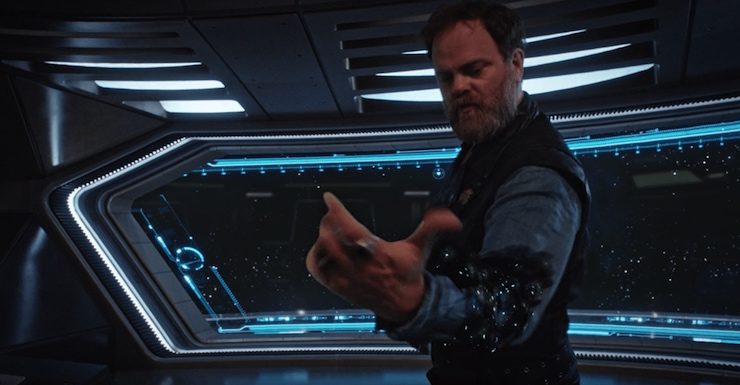Hi—my name is Alasdair, and I love time loop episodes. When done right, they’re a brilliantly efficient piece of storytelling, using the repetition of events and the accretion of knowledge to not only show us more about the characters but often give the writers a chance to have a little fun (and maybe let the production office save a little money). For years, my platonic ideals of this story have been “Cause and Effect” from Star Trek: The Next Generation and “Window of Opportunity” from Stargate SG-1. The former has the best pre-credit sequence ever (Ship explodes! Everyone dies! Cue the music!). The latter has O’Neill and Teal’c trapped in a loop which leads to wormhole golf, a magnificently terrible yellow sweatshirt, and a moment that made fans of a certain ship gleefully punch the air.
Both are immensely fun hours of TV, and recently they’ve been joined among my favorite time loop episodes by three more excellent examples of the form at its absolute best. Here they are:
Star Trek: Discovery
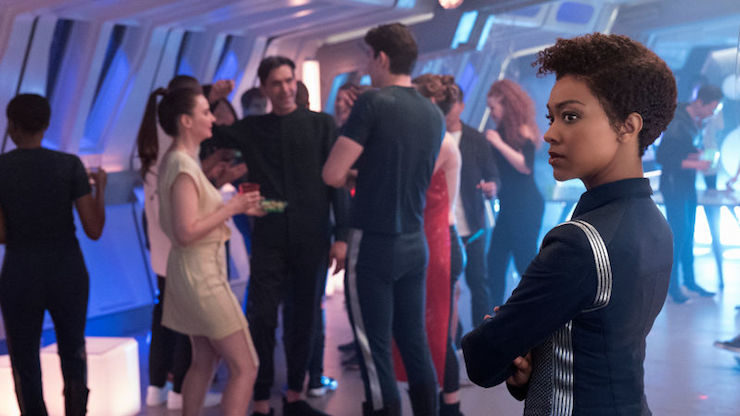
Season 1, Episode 7: “Magic to Make the Sanest Man Go Mad” (Written by Aron Eli Coleite & Jesse Alexander)
When the Discovery takes aboard a Gormagander—an incredibly rare space-going whale-like creature—they get an unexpected passenger: Harry Mudd. Intent on taking vengeance on Lorca for leaving him to die, Mudd has both a plan and a device that allows him to loop time until he gets it right. The only problem is, one of the Discovery crew doesn’t really perceive time the same way everyone else does…
This was the episode where Discovery really found its feet for me, and it remains a season highlight, as well as a Hugo finalist. The fact that it stands out isn’t just due to the time loop plot, either, although that does a really effective job of contextualising Harry Mudd, calling attention to Lorca’s plot, and advancing basically every central narrative of the show. Burnham and Tyler’s romance in particular really works here, as well. It feels real and cautious and complicated (and that’s even before we learn more about Tyler’s true nature in a later episode).
But what’s really memorable here is the way the show takes a very familiar approach to telling its story and then cheerfully refuses to do what you expect with it. I love that Burnham is our POV character but Stamets is the one who the events—but not the story—center on. I love that the situation is resolved by giving Harry exactly what he thinks he wants in a manner that both sets up and provides a framework for his future appearances. Most of all, I love that we get to see a Starfleet crew relax and find that they do so at the same kind of endearingly rubbish, overly enthusiastic parties we’ve all been to at one time or another. After six episodes of appearing as a bunch of slightly grim people in flight suits, in this episode the crew suddenly feel like real, relatable people.
Best of all, though, is the emotional narrative. By building the time loop into the core of the story, the writers are able to ground events in personal experience rather than technobabble. Tyler and Burnham dancing together for the first time is sweet. Stamets and Burnham holding hands as the loop ends again is touching. But Burnham’s moment of self-knowledge, and how she uses it to speed up her reactions in the next loop is what really gets you. Personal, heroic, painfully honest, and one of the moments in the first season where the character really clicked—topped off with some witty, poignant musical cues that riff on the show’s theme—this episode is a real winner.
Cloak & Dagger
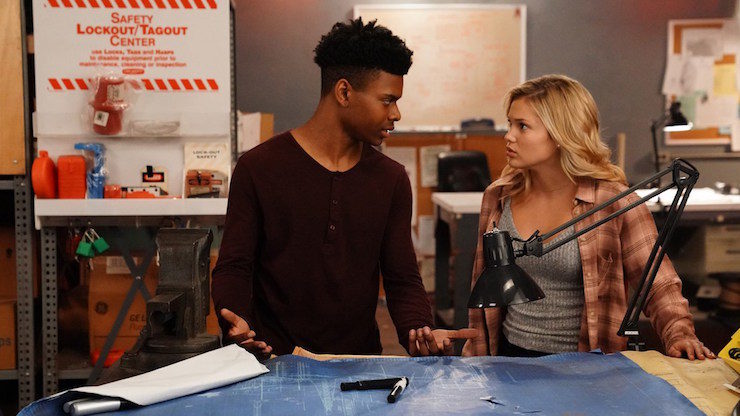
Season 1, Episode 7: “The Lotus Eaters” (Written by Joe Pokaski & Peter Calloway)
Tandy discovers that Ivan Hess, a colleague of her father’s, survived the rig explosion but is in a coma. With Ty’s help, she gets through to him and they both find themselves stuck in Hess’ mind, endlessly repeating the final seconds before the rig blew up…
Cloak & Dagger’s first year ranks among the best television that Marvel have produced to date, and this is its finest hour by a good distance. Like “Magic to Make the Sanest Man Go Mad,” it accomplishes this by structuring the episode around the time loop and using it to do as many different things as possible. That includes moving Tandy’s main plot arc along, giving her a handy training montage, forcing her to confront her feelings about her father, and reinforcing to both Tandy and Ty that they work best as a team. At the same time, it sets up some of the bittersweet and flat-out horrific elements of the next couple of episodes, as we see Tandy watch the Hess family reunite in the exact way her own family can never do.
Best of all, this actually feels like a story about a pair of superheroes learning who and what they are. Ty’s arc gets short shrift after the last couple of episodes but that ties cleverly into the compromise they both have to make in order to work together, and neatly sets up his arc-heavy episodes to come. Plus the episode cleverly cements Ty’s role as the moral compass of the pair, and his decision to go back into Ivan’s mind when Tandy refuses to leave is a vital part of his heroic journey.
For her part, this is Tandy’s finest hour. She channels her need for vengeance into a desire to help someone caught in almost exactly the situation that’s broken her. She does so altruistically, and accepts that what Mina and her father have will forever be denied to her. What she doesn’t see, and can’t know, is that the idealised version of her father she still clings to is the furthest possible thing from the truth. So, just as Ty continues to rise, Tandy crests and begins to fall. It’s complicated and nuanced emotional storytelling, and much like Discovery’s time loop narrative, it sets the tone for the show’s future. And just for the record, anything which gives Tim Kang (who plays Ivan Hess) a chance to show off just how damn good he is?—that’s fine with me.
Legends of Tomorrow
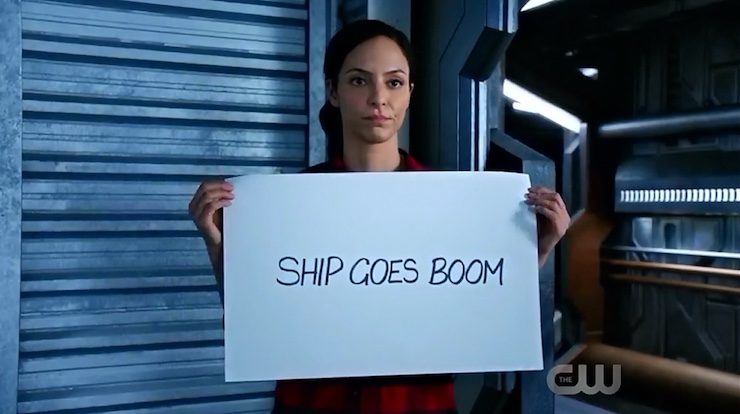
Season 3, Episode 11: “Here I Go Again” (Ray Utarnachitt & Morgan Faust)
The team come back from a mission in the ‘70s to find two things: that Zari’s experimentation may have broken the ship. And…well…time. Even more so than they already have.
Legends of Tomorrow’s third season is immensely good fun. Whether it’s Neal McDonough fighting himself, the world’s most meta John Noble joke, or an ending that is so, SO stupid that it actually comes out the other side into brilliant, the show had a great third year.
Buy the Book
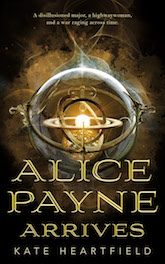

Alice Payne Arrives
This was the best episode of the season for me, because, like the two stories mentioned above, it uses the central mechanism of the time loop as a storytelling engine rather than a destination. Over the course of the episode, not only does Zari slowly realise that her team are much more complicated people than she thought, but the real focus becomes her acceptance of her place with them, even to the point of being willing to die for them. The Legends are history’s greatest underdogs at the best of times, but seeing them as people, not punchlines—as we do in “Here I Go Again”—makes them something more: it makes them truly inspiring. Mick in particular, who is revealed here to be a surprisingly good novelist, gets some welcome character development. He growls a bit about it (because he’s Mick), but it’s still sweetly handled, touching stuff.
Perhaps the strongest aspect of this episode is how it digs into the cost and stakes of this situation. The sheer weight of knowing how long they have left to live and being unable to do anything about it almost breaks Zari. Tala Ashe, whose fantastic deadpan comic timing shines throughout the season, is just as good when facing the grim side of things, and her performance makes us feel the weight of the hours she’s lived. But she’s also able to show us the impish side of Zari, thanks to Nate. Nate and Ray, who brilliantly know exactly what’s going on pretty much the second she tells them, give the show the winking, meta-fictional foundation it needs (See Nate’s “It was only a matter of time before we did one of these!”). It’s in capturing the more earnest, human side of the situation, however, where all three shine, representing the show at its best: Ray with his puppyish enthusiasm, Zari with her sense of humour, and Nate with his fundamental decency and compassion. The result is funny, sweet, and immensely weird, as only the Legends can be.
Time loop episodes are too often viewed as just an exercise in box-ticking, or a fun gimmick with little consequence in terms of plot development. But, as these three episodes show, when done well, a time loop structure can function as a lens that changes how viewers see the show. Just as the characters gain a new perspective on their lives, so do we. The overall effect is less like a loop and more like a slingshot, catapulting viewer and show alike into a different, more nuanced and interesting orbit.
And of course, on occasion, wormhole golf sometimes happens, and that’s always a good thing.
Alasdair Stuart is a freelancer writer, RPG writer and podcaster. He owns Escape Artists, who publish the short fiction podcasts Escape Pod, Pseudopod, Podcastle, Cast of Wonders, and the magazine Mothership Zeta. He blogs enthusiastically about pop culture, cooking and exercise at Alasdairstuart.com, and tweets @AlasdairStuart.










